Fresh, cutting edge content delivered direct to your inbox and as interactive lessons
within Starry Night software & curriculum.

Until recently, our solar system was the only planetary system humans knew. It was even thought by some that our solar system was unique in the universe. This changed in the early 1990s, when astronomers began to discover the first exoplanets, worlds orbiting other stars. Since the first discovery, astronomers have found thousands of other exoplanets. Astronomers now believe that planetary systems are plentiful throughout the universe.
A highly interactive version of this lesson plan with additional features is available for users of Starry Night software. To find this content in Starry Night open the SkyGuide pane and click on the Teachable Moments or Learning Moments icon depending on which version of the software you own. If you do not own Starry Night, you can still use this document to learn more about the TRAPPIST-1 system. Starry Night is available for desktop computers, Chromebook, and mobile devices. Educational versions are available that teach all your Astronomy and Space Science topics by combining interactive software exercises, hands-on activities and thought- provoking discussion questions. You’ll be amazed at how quickly your students grasp the fundamentals of astronomy.
Learn more by visiting us at StarryNightEducation.com
On late February 2017, NASA made worldwide news with the extraordinary announcement that around a small, ultra-cool, and relatively nearby star, they found seven rocky Earth- sized planets, all of which could potentially have liquid water given the right conditions. This was the largest batch of Earth-sized planets discovered around a single star.
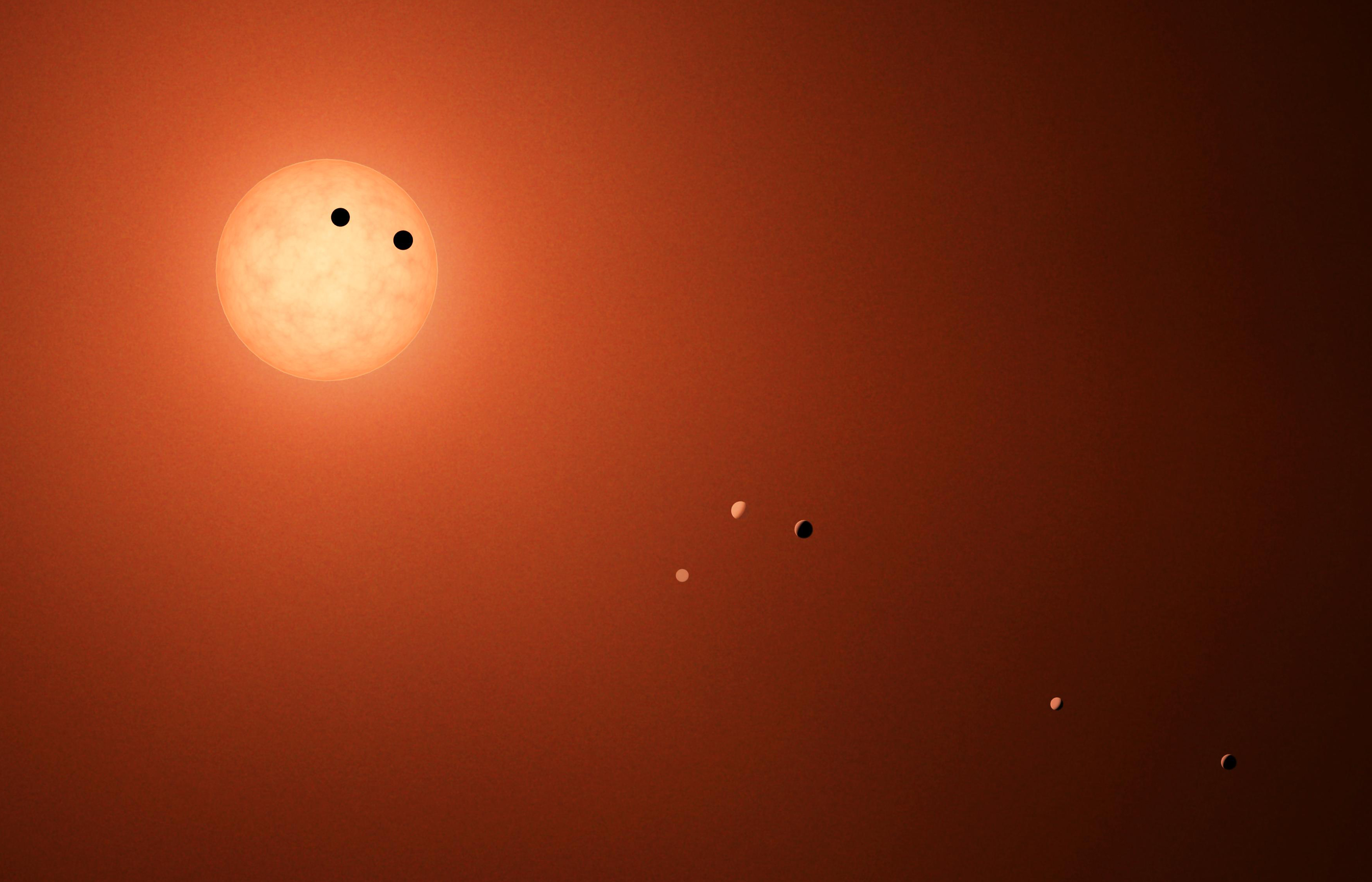
The new exoplanet system, called TRAPPIST-1, is the first discovery by The Transiting Planets and Planetesimals Small Telescope (TRAPPIST) in Chile, which initially detected three of the planets in May 2016. The TRAPPIST project, operated by the University of Liege in Belgium, uses robotically controlled 60 cm (24”) aperture telescopes to measure tiny variations in a stars’ light produced by orbiting exoplanets that periodically pass in front of the stars and dim their light in a particular way. The orbiting Spitzer Space Telescope, and the Very Large Telescope (VLT) at Paranal, Chile were called upon for further study, and detected the four additional exoplanets.
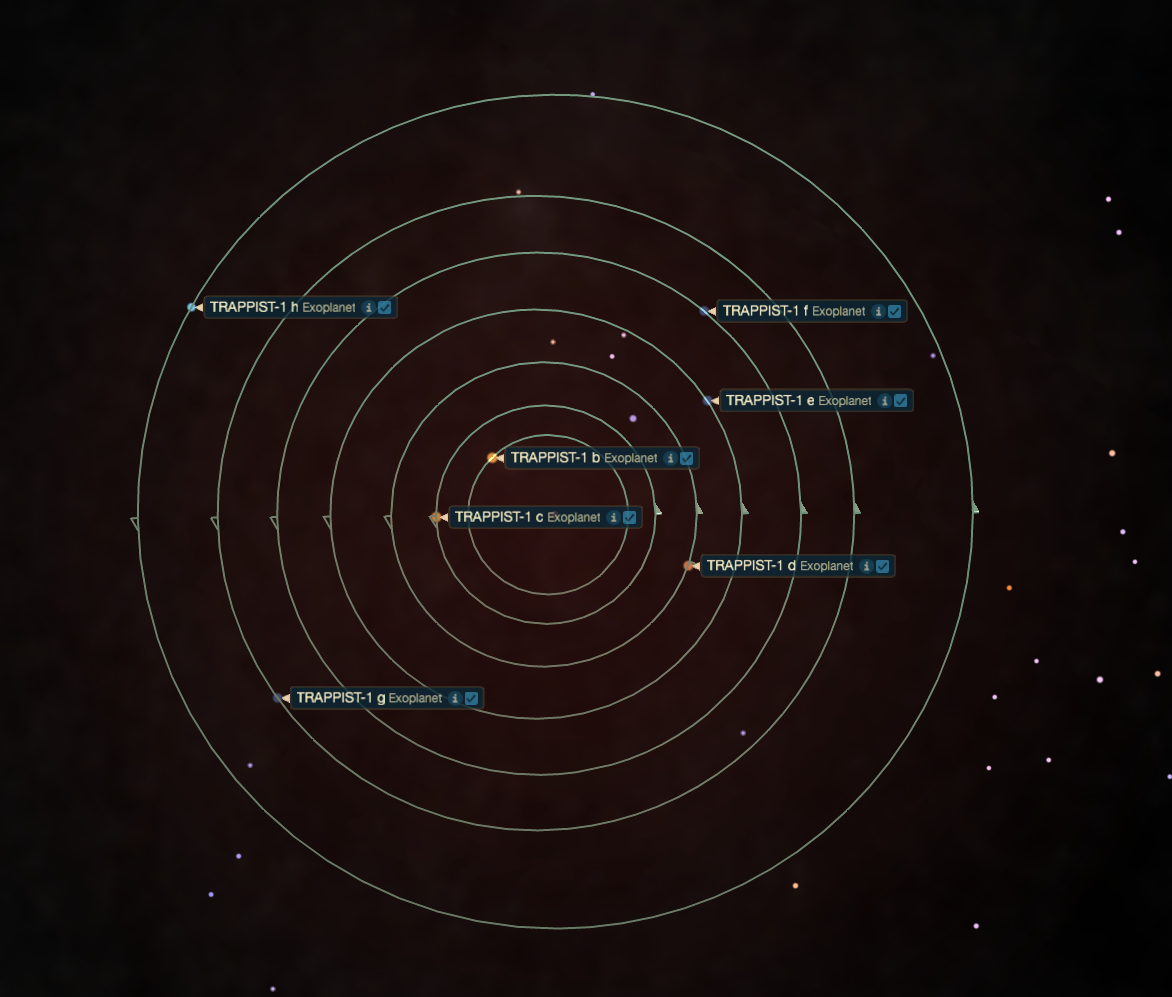
Several things make this news so exciting. Three of the planets orbit within their star’s habitable zone – the distance from a star that’s not too hot or too cold – where water, if present, could exist in a liquid state on a planet’s surface. Never before have so many planets been detected within the habitable zone of a single star. In fact, it’s possible that liquid water might exist on all 7 planets if the atmospheres of these worlds have the right conditions.
Finally, the distance to the system is only 39.5 light-years – putting future study of the planets’ atmospheric compositions within reach of the next generation of telescopes. Detection of oxygen and other biologically-generated gases could reveal an alien eco-system.
An exoplanet is named after the star it orbits, followed by a lowercase letter (starting with "b". Progressive lowercase letters are used (c, d, e and so on) when more than one planet is found in a system, with the letters assigned in order of discovery, not distance from the star. The TRAPPIST-1 planets were the exception, they were assigned letters in order of distance after subsequent planets were discovered.
If advanced intelligent life has evolved in the TRAPPIST-1 system, they could already have detected our radio and television transmissions. Our broadcasts of Happy Days, Three’s Company, and Charlie’s Angels are arriving there now. Our own SETI (the Search for Extra- terrestrial Intelligence) has monitored the TRAPPIST-1 system for any artificial radio signals but so far has not detected any alien transmissions. Further surveys however, will be conducted in the future.
While a great many Earth-sized extra-solar planets (exoplanets, for short) have already been catalogued, this discovery brings us another step closer to answering one of the big questions in the universe. Are we alone?
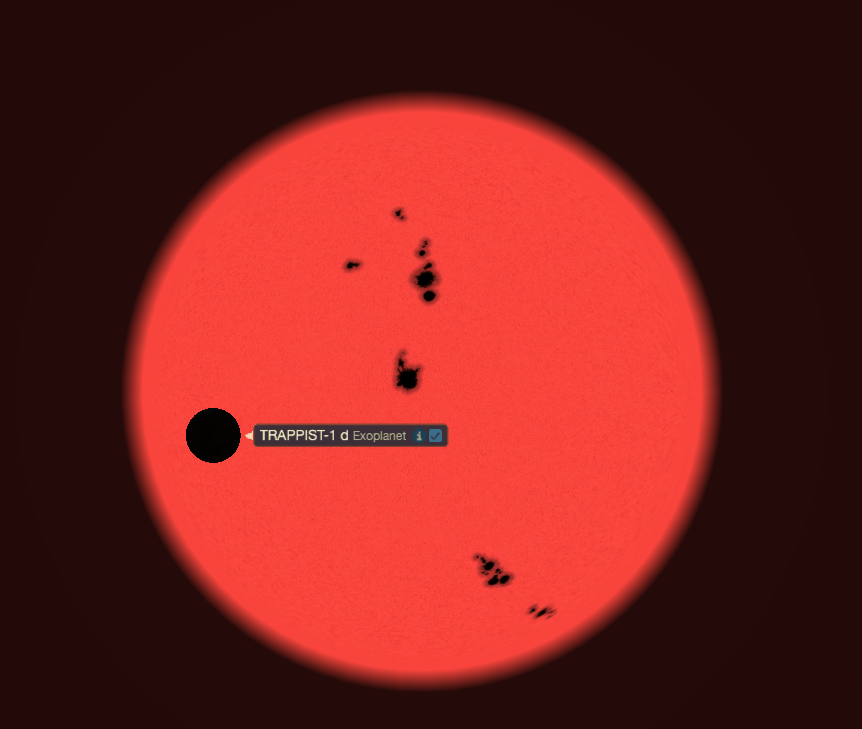
Apart from a few special exceptions, directly observing planets hidden in the glare of their stars is beyond our current technology. So we have to rely on indirect methods to detect and characterize them. By far, the easiest methods involve measuring the small effects that the planets have on their star. The most fruitful of these techniques has been Transit Photometry - measuring the dimming of a star’s light when its planets pass between us and the star. Radial Velocity and Stellar Astrometry are other methods that detect the subtle motions of stars caused by orbiting planets tugging on them gravitationally. The TRAPPIST-1 discovery used the transit method.
Transit methods only work for the small percentage of star systems that are oriented edge-on towards Earth. Fortunately, that’s still a lot of stars! On a regular interval each planet transits the disk of its star, temporarily causing a slight reduction of the star’s light (on the order of 1 part in 10,000) as viewed from Earth. The amount of the reduction is proportional to the size of the planet. The dip re-occurs every time the planet completes an orbit. By recording the brightness of the starlight continuously over a long period of time, we can determine the length of a planet’s year and the radius of its orbit.
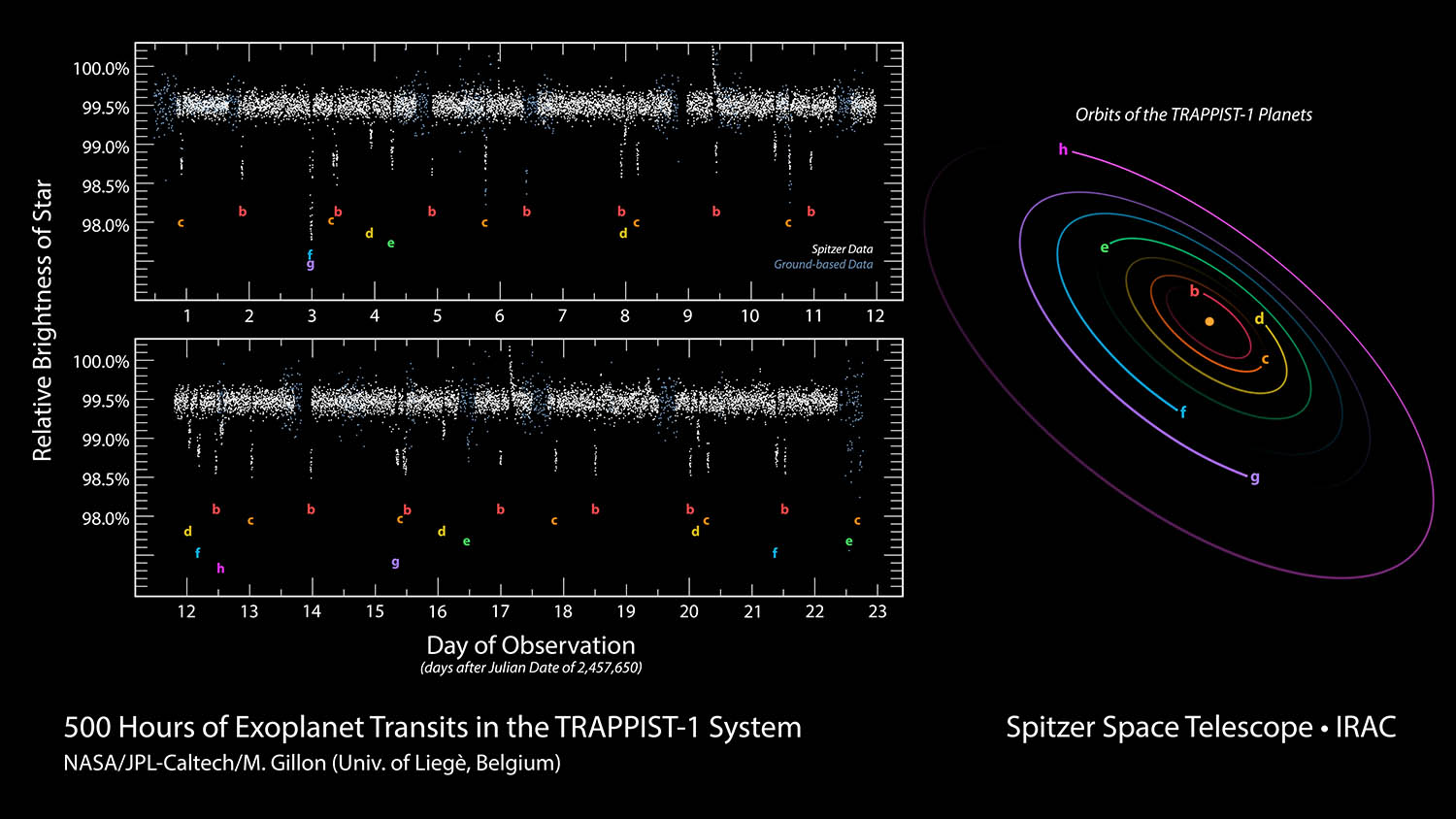
The graphs of starlight versus time, known as light curves, can be complex if multiple planets are transiting – each with a different dip amount, duration, and interval – all summed together. Many stars exhibit inherent variability in their brightness, too, but the exoplanet transit dips are usually brief by comparison.
Small, Earth-sized planets produce tiny dips in light intensity. If a star is being examined using a ground-based telescope, daytime prevents continuous measurements, and atmospheric interference (i.e., twinkling) adds noise to the light curve, limiting the sensitivity and preventing the detection of small planets. To overcome this, observatories such as the Kepler Space Telescope are launched into orbit. They detect and characterize exoplanets, especially Earth-like ones, by using Transit Photometry continuously on a single small patch of sky. Kepler has discovered thousands of exoplanets, including many hot Jupiter and Neptune-sized planets, and a good number of Earth-sized planets.
The Spitzer space telescope is another space-based observatory that was originally launched as an infrared observatory. With its primary mission long completed, and some of its instruments no longer operational, it is still functional as an exoplanet observer.
The time taken for the transit yields the speed of the planet, and the time interval between transits provides its orbital period (its year). These parameters allow the orbit to be calculated using laws of orbital dynamics, including the planet’s mass and its distance from the star. The amount that the host star’s light diminishes while an exoplanet transits gives astronomers the diameter of the exoplanet. Knowing its diameter and mass provides its density.
Combined with the star’s luminosity and spectral type, astronomers estimate the surface temperature of the planet. Moreover, if an exoplanet has a translucent atmosphere, or is a gas world, the reduction in light drops gradually, while one that is rocky and airless diminishes more abruptly.
It was only in 1992 that astronomers Aleksander Wolszczan and Dale Frail confirmed the first exoplanets, found in orbit around the pulsar PSR B1257+12. Pulsars emit too much radiation to allow the existence of organic life, so scientists continued looking for proof of other planets orbiting stars like our own, where life might have a chance to emerge and thrive. Astronomers Michel Mayor and Didier Queloz found the first exoplanet orbiting a Sun-like star in 1995 - 51 Pegasi b - 50.9 light-years from Earth in the constellation Pegasus.
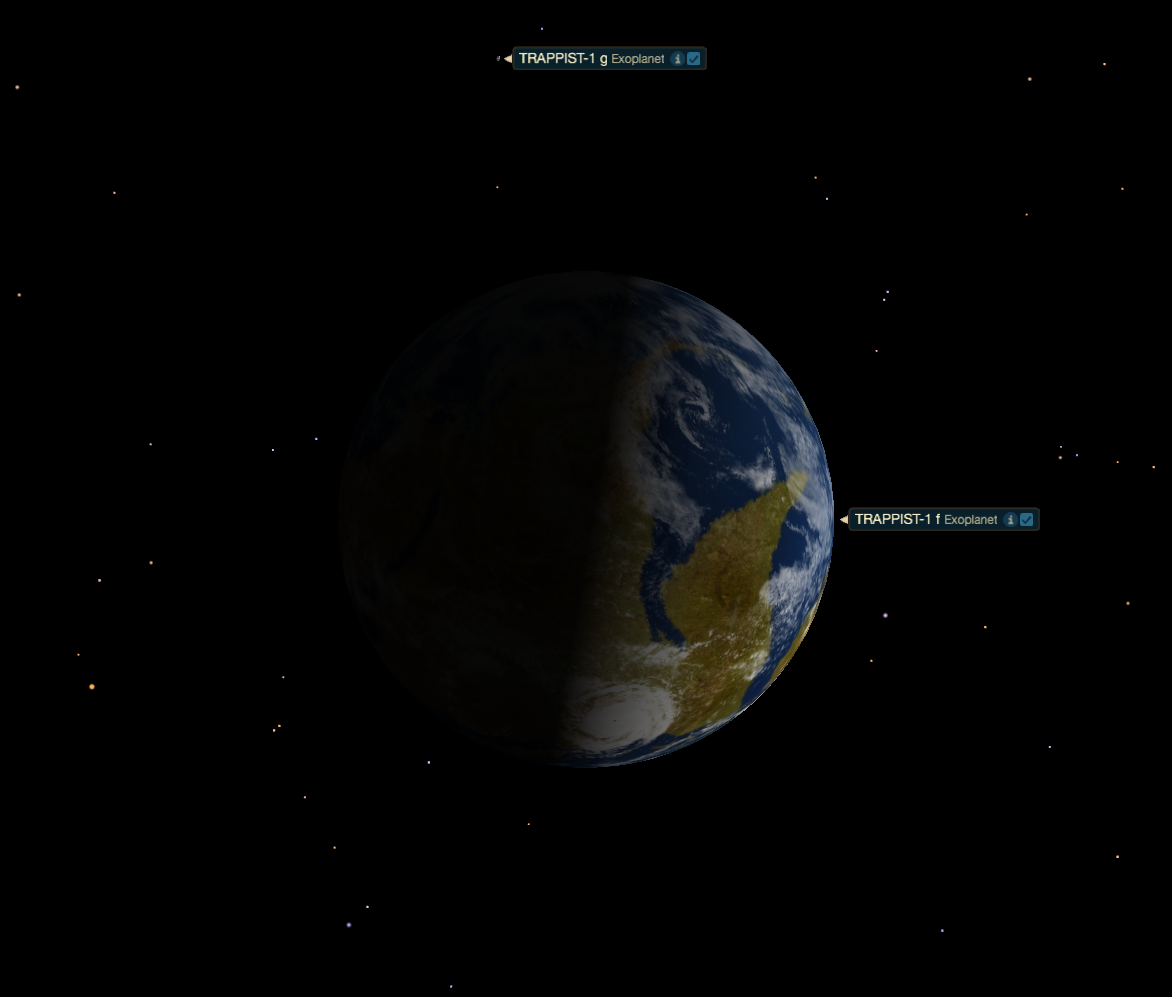
Extrapolating the numbers we have today, astronomers estimate that our galaxy could be home to 40 billion Earth-sized planets, 11 billion of them orbiting Sun-like stars! The TRAPPIST-1 system discovery also proved that dim red dwarf stars are also viable hosts for Earth-like planets. This is particularly exciting because red dwarf stars like TRAPPIST-1 far outnumber stars like our Sun.
Many exobiologists believe that the sustained presence of liquid water is necessary for Earthtype life to be possible on an exoplanet. At reasonable atmospheric pressures, stable liquid water occurs between about 0° and 100° Celsius (32° to 212° Fahrenheit). If the orbit of an exoplanet around its host star keeps it close enough for water to avoid freezing, yet not hot enough to boil it away, it’s considered to orbit within the star’s habitable zone
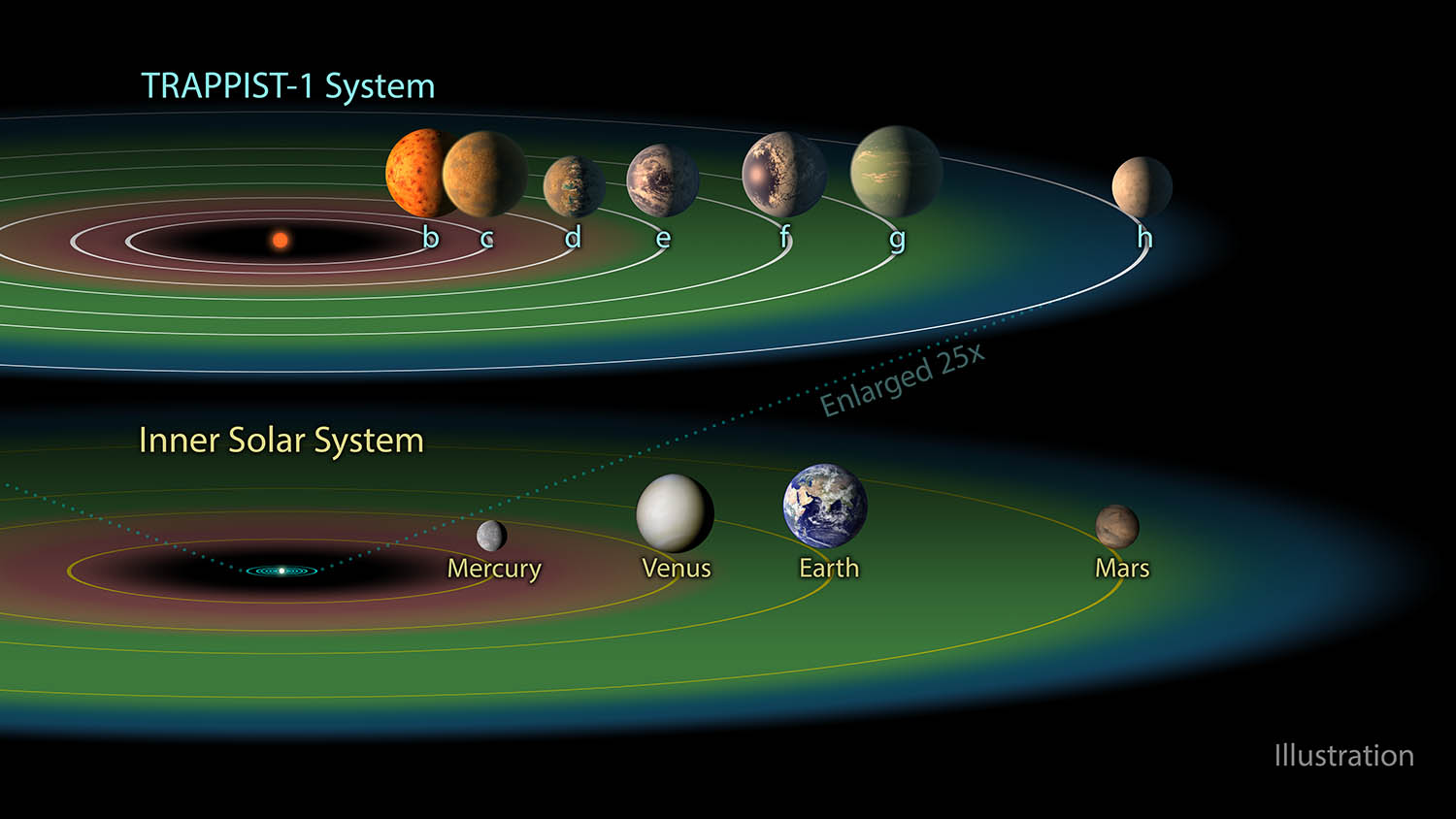
The habitable zone for our Sun extends from Venus’ orbit almost out to Mars. To avoid overheating an exoplanet, the habitable zones of hot stars have to be farther from the star, so the planet’s year will be longer. But hot stars live fast and die young – some as short as tens of millions of years – probably too short to allow time for life to originate and evolve. Cool stars, especially red dwarfs, shine for hundreds of billions of years. Their habitable zones are compact, and there is plenty of time for life to arise. Unfortunately, orbiting closer to a star also exposes a planet to increased harmful radiation, and space weather events like flares and coronal mass ejections.
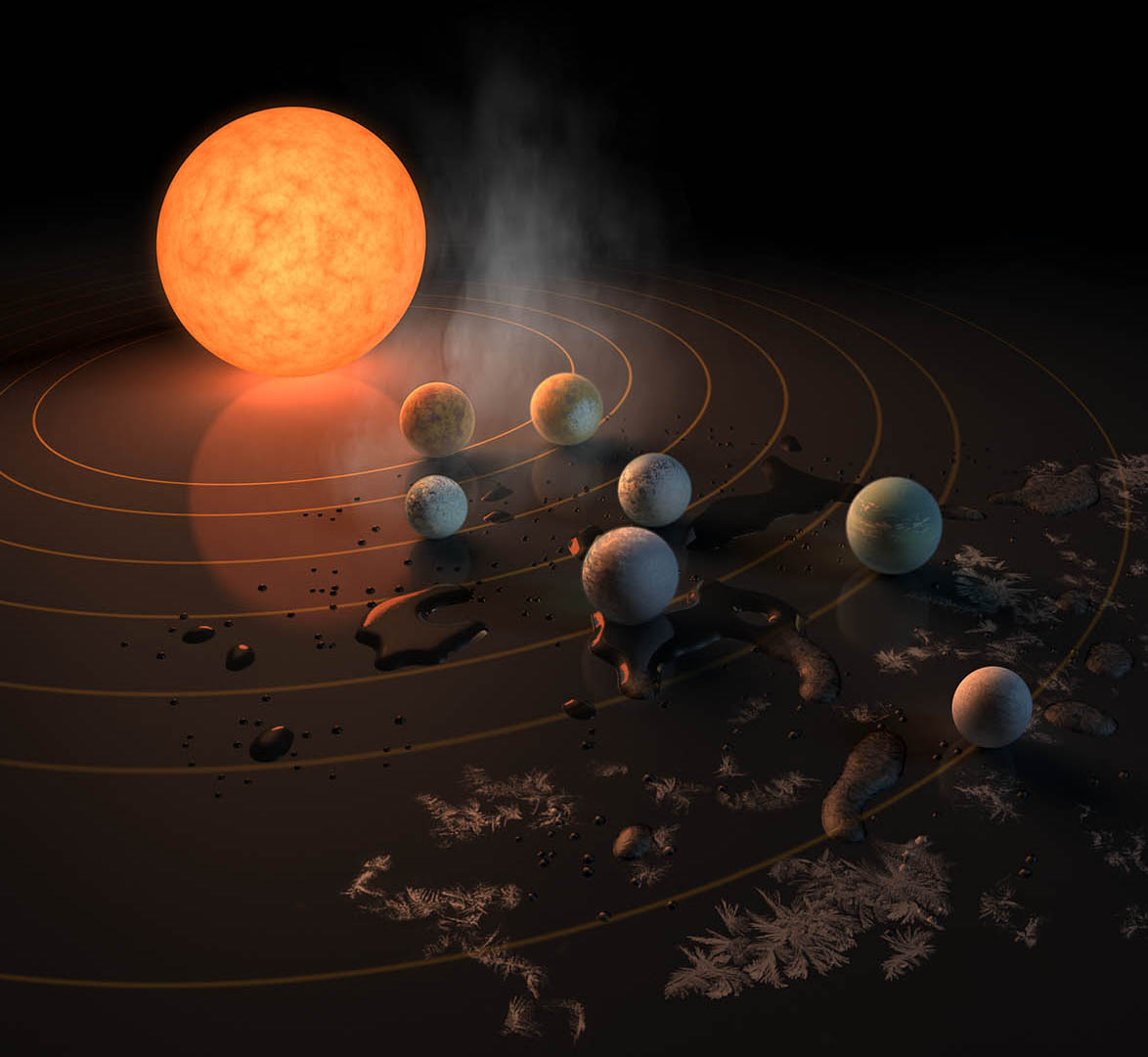
Finally, the mass of the planet must be sufficient to exert enough gravitational attraction to hold on to a protective atmosphere, and volatiles like water. Mars is not large enough to have kept its atmosphere and water for long, resulting in its cold, dry state today. It’s not surprising then that scientists talk about “The Goldilocks Zone” for extra-terrestrial life. The planet has to be large enough, not too hot, and not too cold – just right, for life!
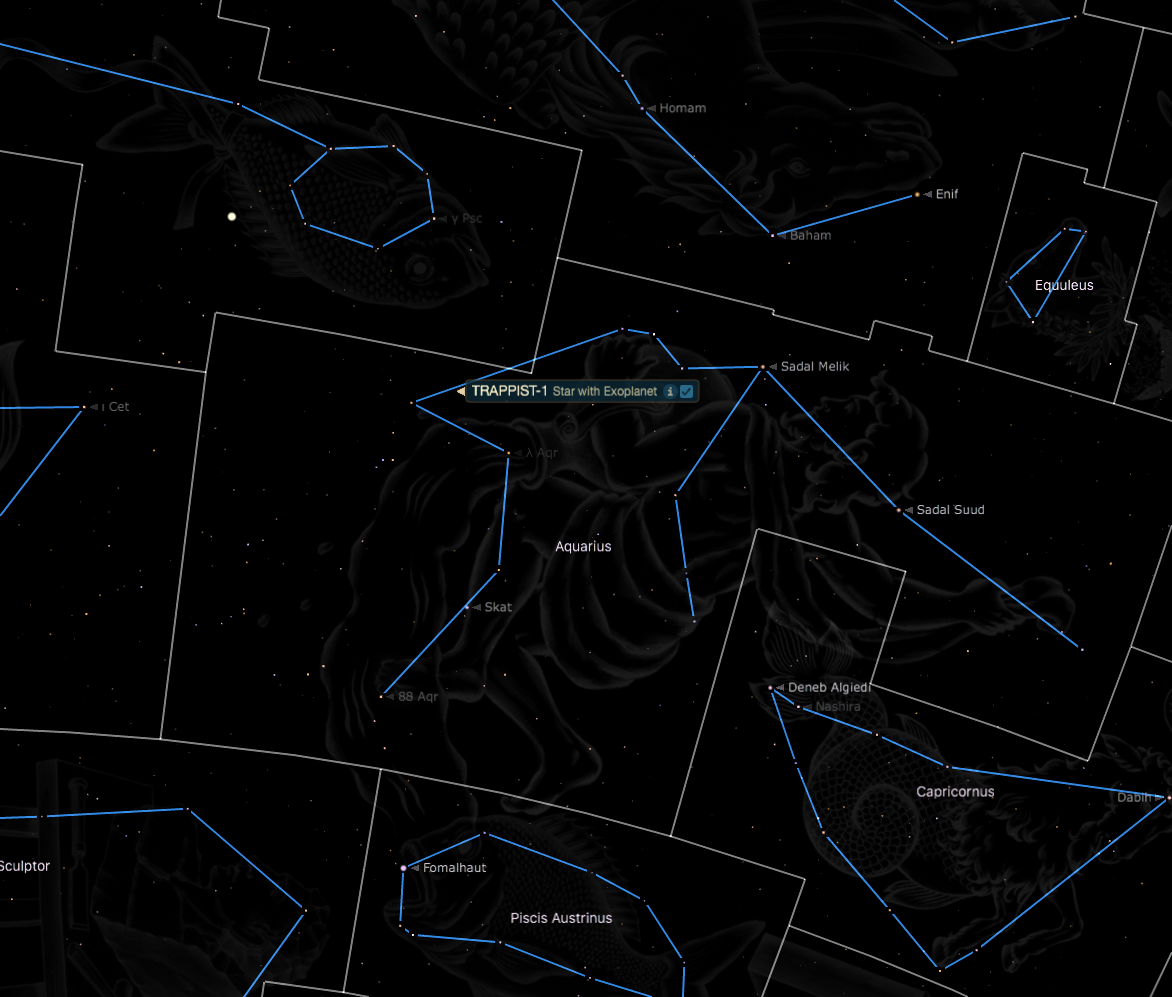
The star hosting the new exoplanets is about 4.25 degrees to the east of the star Hydor (Lambda Aqr) in the constellation of Aquarius. The pre-discovery name of the host star was 2MASS J23062928-0502285, as catalogued in the Two Micron All-Sky Survey (or 2MASS). With an apparent visual magnitude of +18.8, it’s far too dim to observe with a backyard telescope. The star’s new designation, TRAPPIST-1, denotes the first system discovered by the TRAPPIST telescope.

Exoplanets are usually named in order of discovery, by adding a lowercase letter, starting with “b”, to the star’s designation. So the new planets are designated as TRAPPIST-1b through TRAPPIST1-1h. The ground-based telescopes initially detected two planets (b and c), plus a possible third one, designated d. The Spitzer Space Telescope confirmed b and c, but the signal for “d” was revealed to be a combination of three planets (e, f, and g). In the process, two new planets, designated d and h were discovered. The decision was made to order the planets by distance from the star.
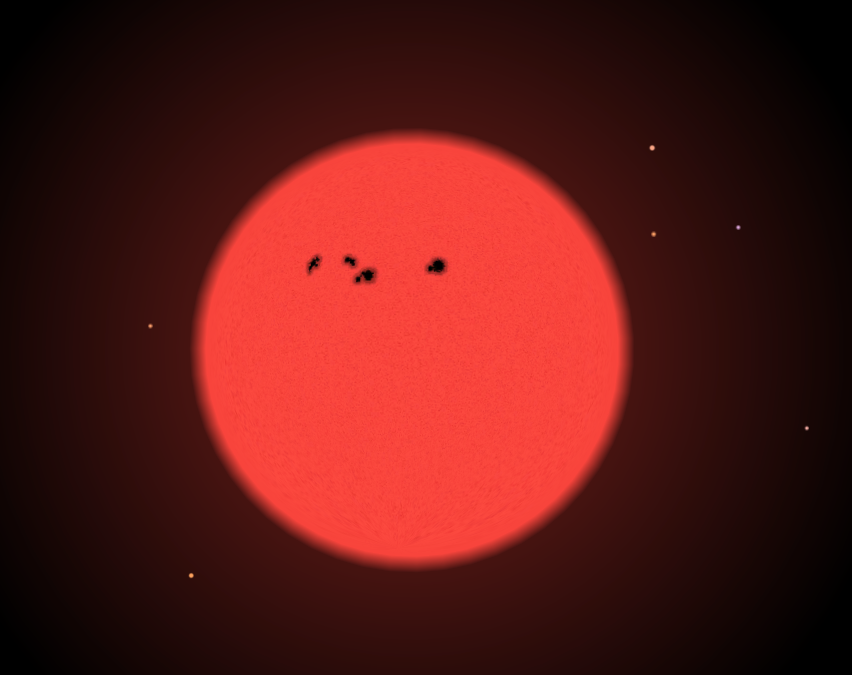
The TRAPPIST-1 star is an ultra-cool red dwarf of spectral class M8. It is approximately 8% of the mass of our sun, and 11% of its diameter, making it slightly larger, but 84 times more massive than Jupiter. Red dwarf stars age far more slowly than hotter, larger stars. TRAPPIST-1 has an estimated surface temperature of 2,550 K, and is about 500 million years into a 12 trillion year life-span. By comparison, our Sun’s surface is 5778 K, and is about halfway through a 10 billion year life-span.
Long-lasting stars intrigue exobiologists because they allow so much time for life to arise and evolve. But at only 500 million years old, the TRAPPIST-1 star may be too young for life to have arisen already.
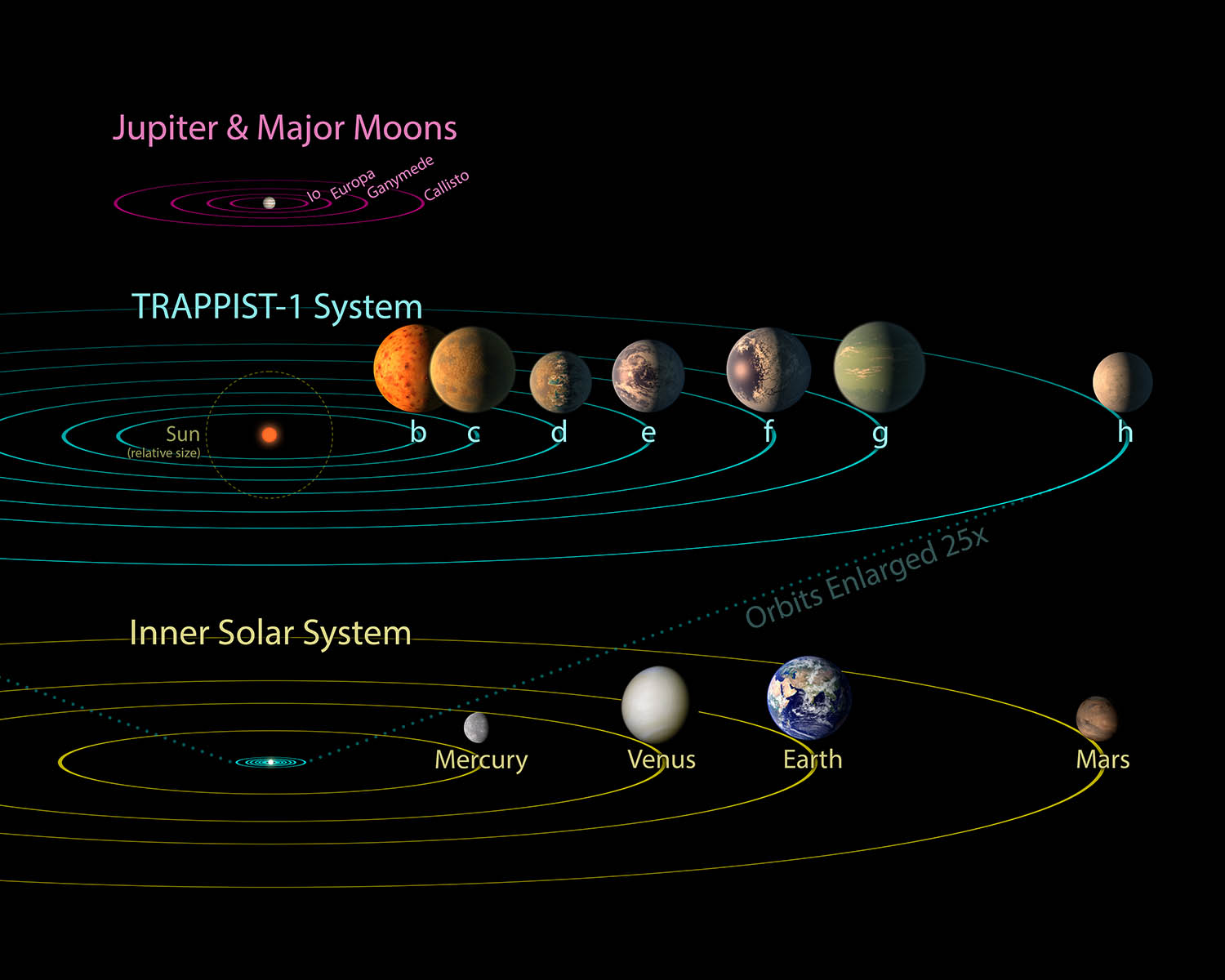
The TRAPPIST-1 star shines with only 0.000373% of the visible light that the Sun emits. It emits proportionately more infrared radiation than our sun. Viewed from the surfaces of orbiting planets, the star would glow a dull red. The habitable zone for TRAPPIST-1 extends 4 to 7 million km from the star, enough for three of the planets to occupy it.
The size of the Trappist-1 Solar System is one of the remarkable features of it. Not only is the star Jupiter-sized, but the bounty of planets around it fit within a volume of space roughly three times larger than the orbits of Jupiter’s four Galilean moons. The outermost star, TRAPPIST-1h, orbits only one-sixth as far from its star than Mercury does from our Sun!
The nearest known exoplanet is located just 4.2 light-years from Earth and circles the closest star to our Sun - Proxima Centauri - a small red dwarf star that is part of a triple star system known as Alpha Centauri. The exoplanet, known as Proxima Centauri b, has a mass 1.3 times the Earth (indicating it might be rocky) and orbits within the habitable zone of its star every 11.5 days at a distance of about one-tenth the space between Mercury and the Sun.
Let’s review the seven planets’ physical characteristics. Many parameters have been calculated, including their sizes, masses, and densities, their average surface temperatures, and the amount of irradiation (sunlight) they receive. We are least certain about the TRAPPIST-1h values because fewer transits have been measured – only one transit, by Spitzer, compared with 37 transits for the innermost planet.
Their densities range from about 60% to 117% of Earth’s 5.51 grams per cubic cm, indicating that they are predominantly rocky. The densest ones, 1c and 1d, probably have a heavy iron core surrounded by a silicate rocky mantle. The least dense ones could contain up to 25% water in liquid form or as ice - or simply appear larger in diameter due to an opaque atmosphere, reducing the calculated density.
The planet with the largest radius and most mass, TRAPPIST-1g, is the outermost exoplanet in the habitable-zone, and the best candidate for liquid surface water or ice and an atmosphere. The smallest is 1d, which sits just inside the habitable zone, and likely has little or no surface water.
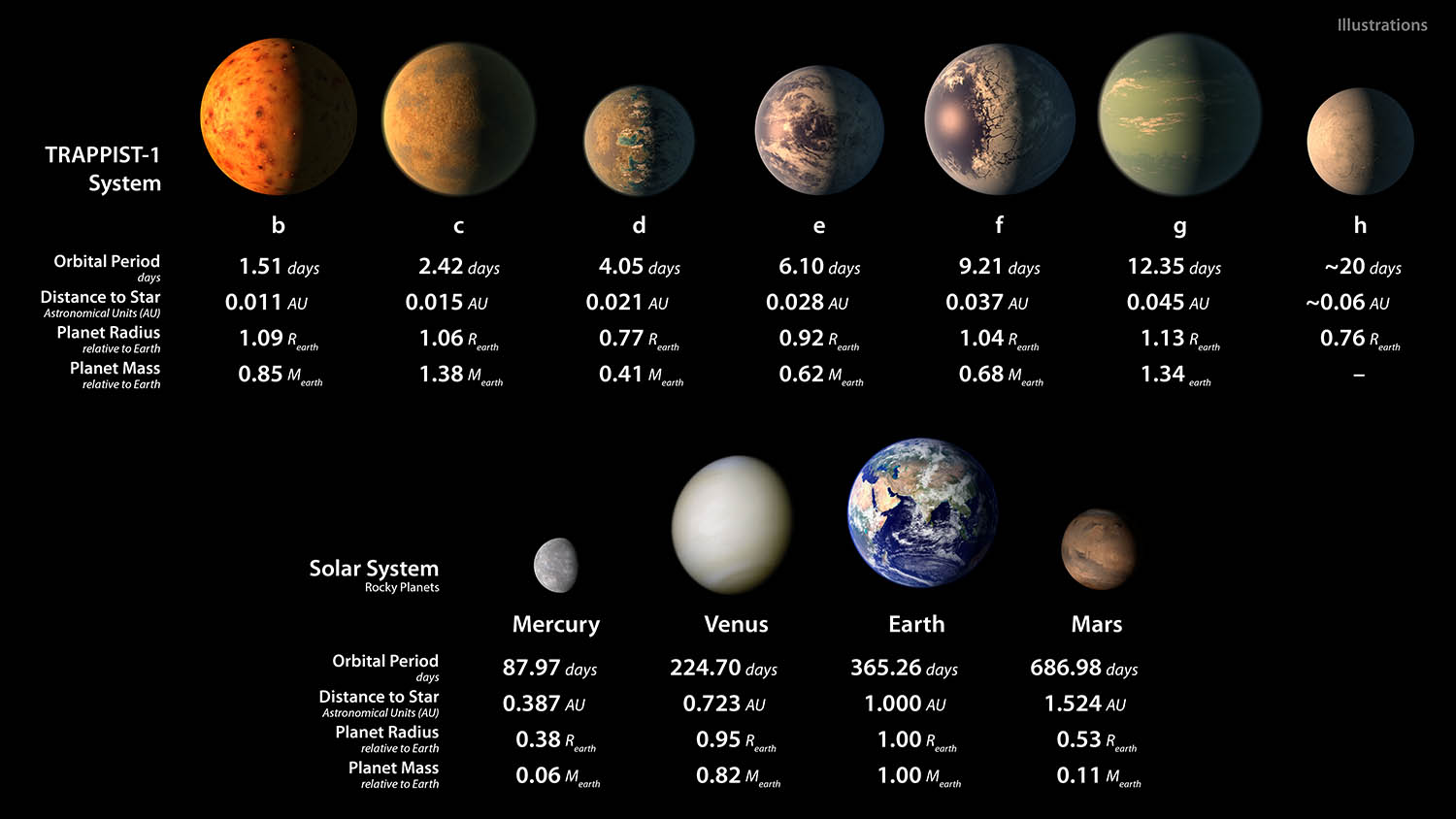
Based upon the brightness of the red dwarf star and the distance from the star, astronomers have calculated the amount of sunlight received on the surface of each planet compared to that received by Earth. Despite orbiting dramatically closer to their star, they receive amounts similar to our solar system. TRAPPIST-1b receives 4.25 times the amount of sunlight we get on Earth (a bit less than Mercury does), and TRAPPIST-1h receives one- eighth of what we receive (similar to what dwarf planet Ceres receives). The mean surface temperatures range from 400 K (127°C) for innermost TRAPPIST-1b to a chilly 168 K (-105°C) for distant TRAPPIST-1b. The planets in the habitable zone range between 251 K and 199 K (-22°C and -74°C), allowing their equatorial and temperate regions to have Earth- norm temperatures.
TRAPPIST-1b is the planet closest to the star, orbiting in a near-circular orbit at a distance of only 1.66 million km (0.011 AU). It is approximately 85% of the mass of the Earth (comparable to Venus), but almost 9% larger in radius, suggesting it contains more water/ice or other lighter elements than Earth. It receives 4.25 times more solar irradiance than Earth, giving it a mean surface temperature of 400 K (127°C) – too hot for surface water or Earth- like life to be present.
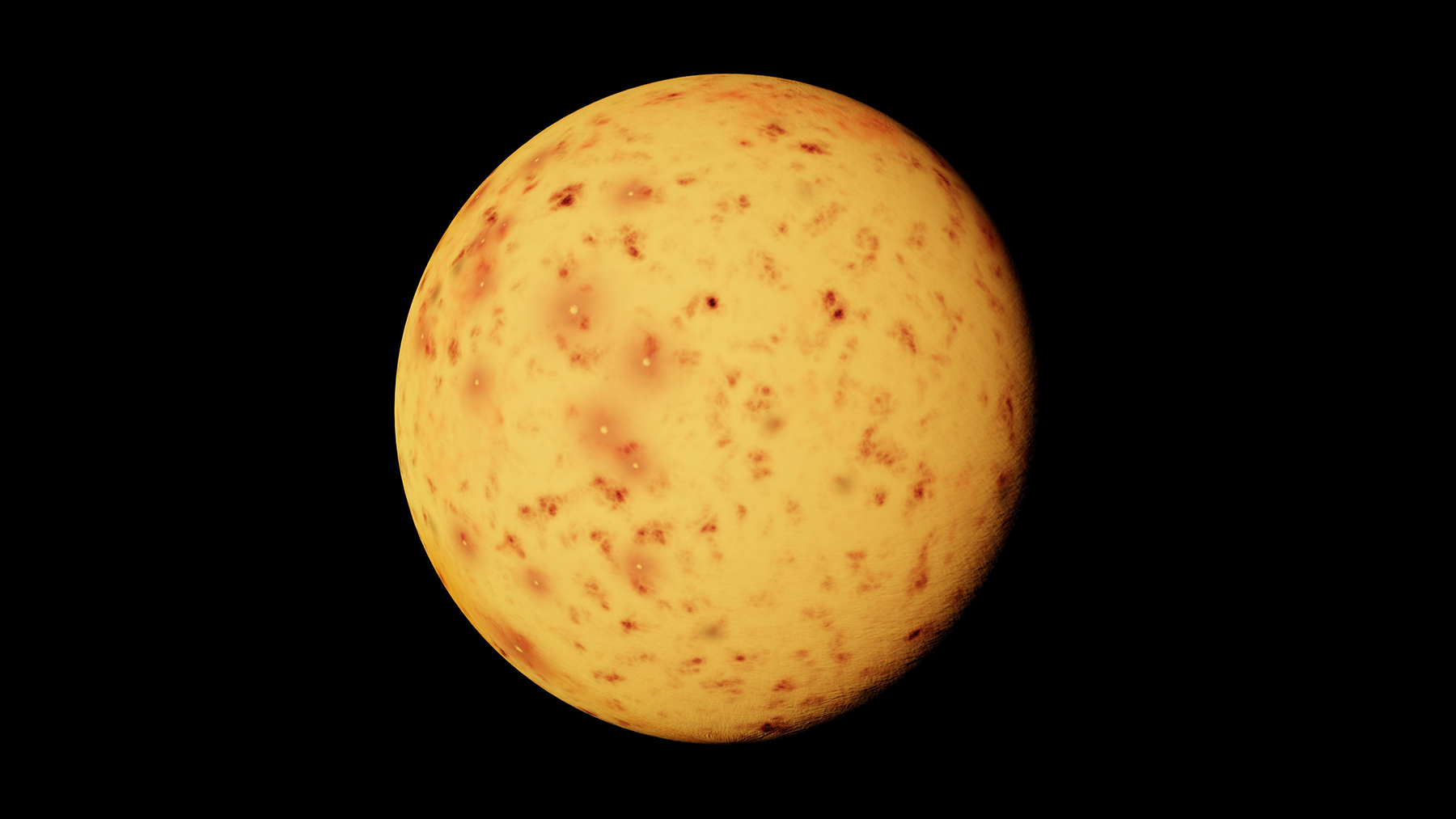
The star’s size as viewed from the surface of TRAPPIST-1b would be 5.6 degrees across, more than 11 times larger than we see our own Sun. The planet is tidally locked to its star, keeping the same face towards it at all times. For a visitor to the sunward side of the planet, the dull red sun would hang in place, neither rising nor setting. On the opposite side of the planet, it would be perpetually dark, broken only by the other six planets racing across the sky, regularly passing near or in front of one another. Unlike our Solar System, the other six planets are close enough to show as small disks, even with naked eyes. At closest approach, the next planet out, TRAPPIST-1c would appear nearly three times larger than the moon does from Earth! Meanwhile, the distant stars would rise in the east and cross the sky to set in the west a little slower than they do on Earth. With a year only 1.51 Earth-days long, the entire celestial sphere would be observable every 36 hours!

TRAPPIST-1c is the second closest planet to the star, orbiting in a near-circular orbit at a distance of only 2.27 million km (0.015 AU). It is approximately 1.38 times the mass of the Earth, but only 6% larger in radius, suggesting it has a silicate rocky composition similar to Earth, but with a slightly larger iron core. It receives 2.27 times more solar irradiance than Earth (similar to Venus), giving it a mean surface temperature of 342 K (69°C) – considered too hot for surface water or Earth-like life to be present.
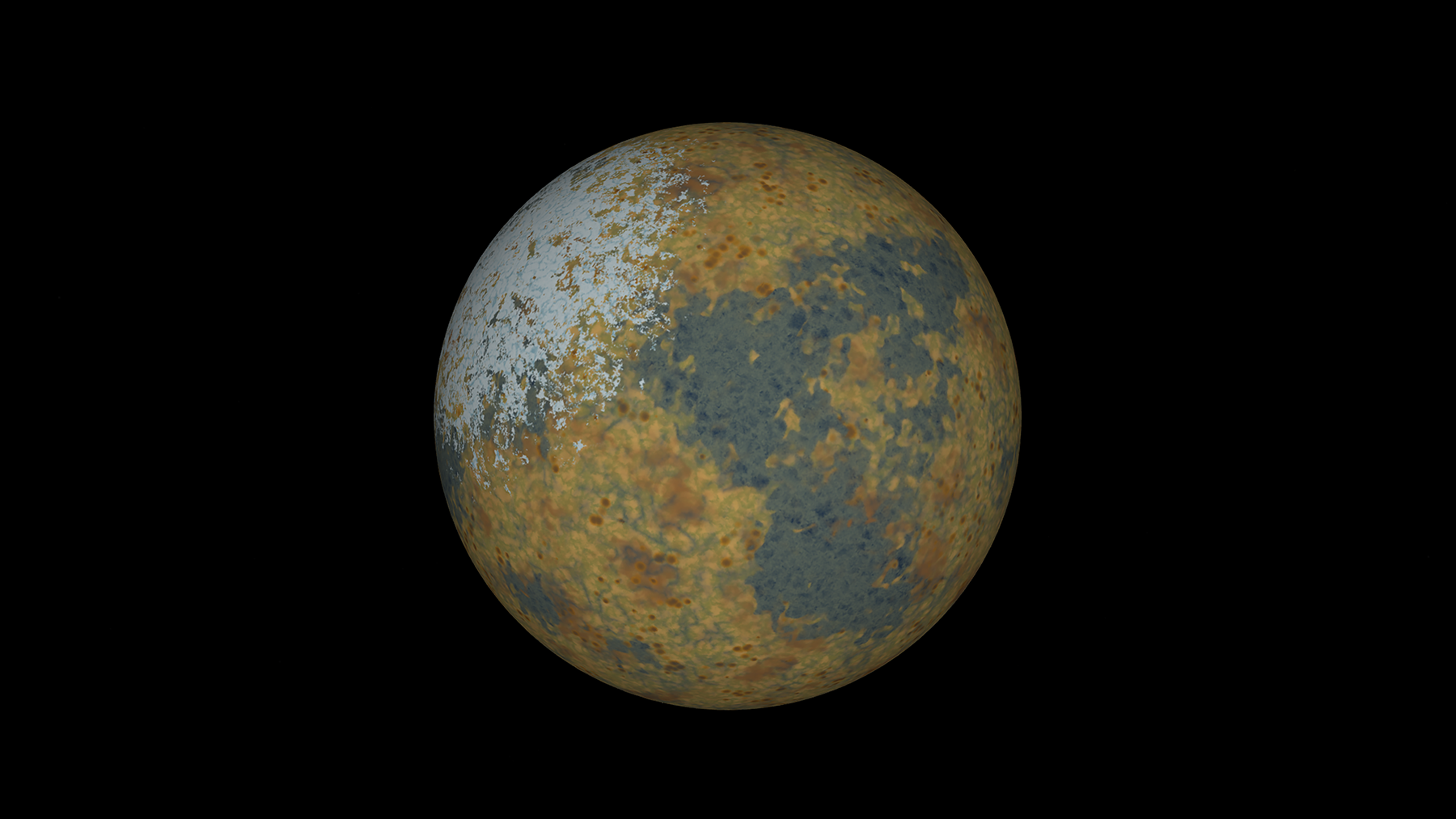
The star’s size as viewed from the surface of TRAPPIST-1c would be 4.1 degrees across, more than 8 times larger than we see our own Sun. The planet is tidally locked to its star, keeping the same face towards it at all times. For a visitor to the sunward side of the planet, the dull red sun would hang in place, neither rising nor setting. The inner planet TRAPPIST-1b, appearing nearly three times larger than our moon does from Earth, would regularly cross the sky, probably transiting (but not eclipsing) the sun’s disk each time. On the opposite side of the planet, it would be perpetually dark, broken only by the other five planets racing across the sky, regularly passing near or in front of one another. Unlike our Solar System, the other TRAPPIST-1 planets are close enough to show as small disks, even with naked eyes. At closest approach, the next planet out, TRAPPIST-1d would cover 0.69 degrees, a bit larger than the moon does from Earth. Meanwhile, the distant stars would rise in the east and cross the sky to set in the west a little slower than they do on Earth. With a year only 2.42 Earth- days long, the entire celestial sphere would be observable every 58 hours!
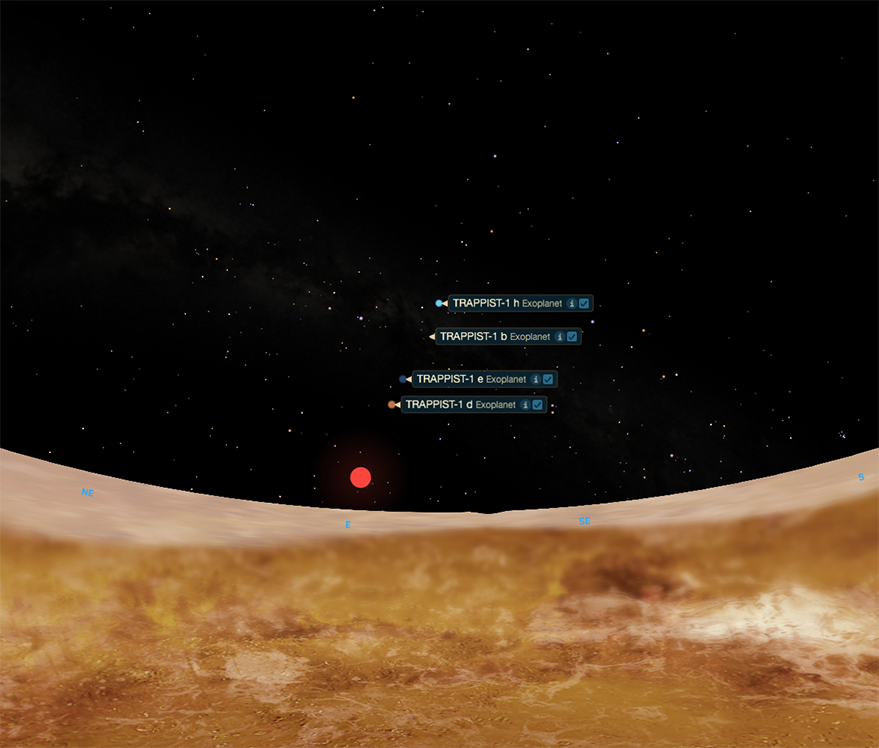
TRAPPIST-1d is the third closest planet to the star, orbiting in a near-circular orbit at a distance of only 3.21 million km (0.021 AU). The smallest planet, it is approximately 41% the mass of the Earth and 23% smaller in radius, making it somewhat larger than Mars. It has a density slightly lower than Earth’s, suggesting a silicate rocky composition similar to Earth, but with a slightly smaller iron core. It receives 1.14 times more solar irradiance than Earth, giving it a mean surface temperature of 288 K (15°C). Like Mars, its low gravity would have trouble retaining an atmosphere. Therefore it is not likely to be habitable.
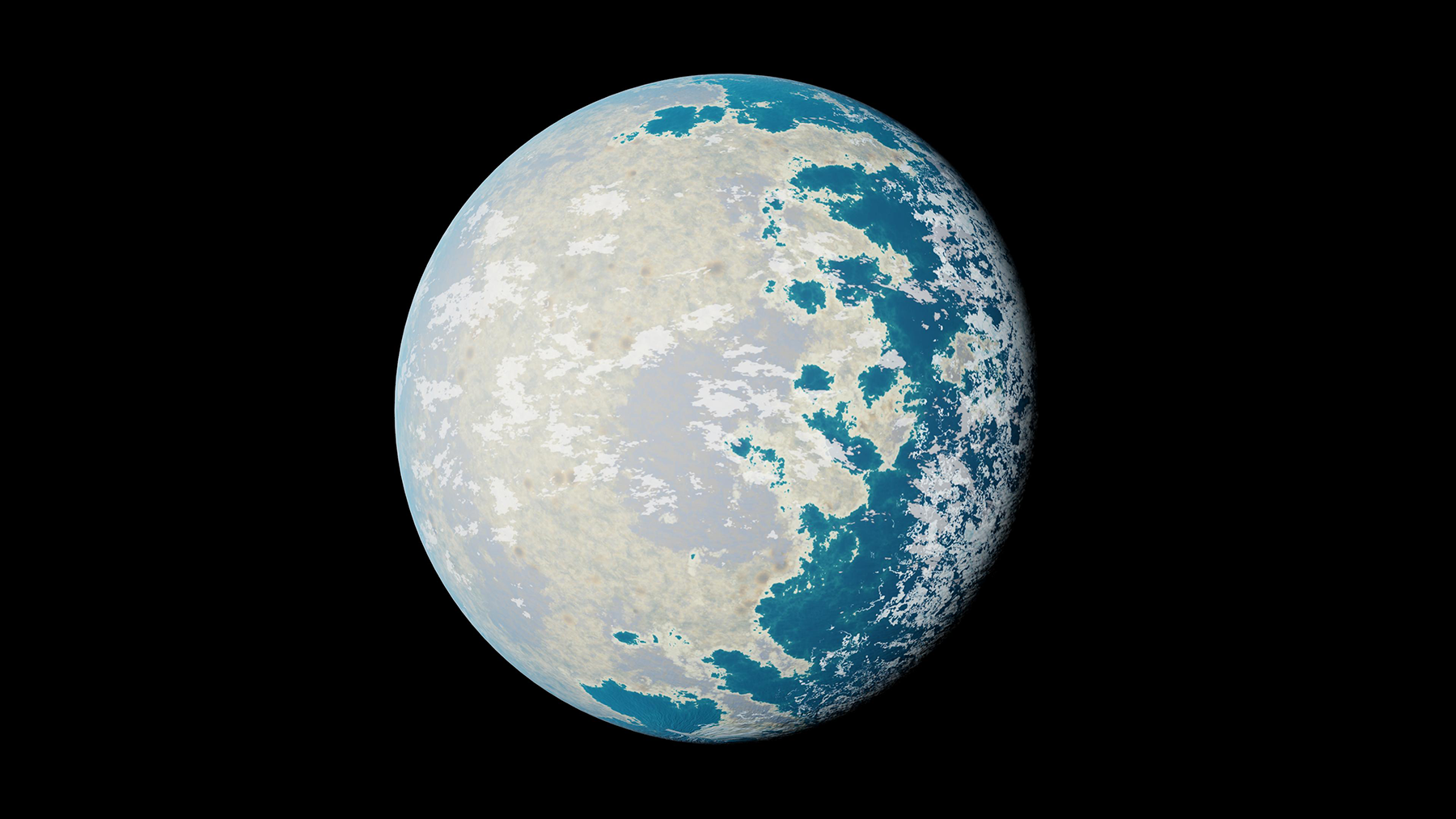
The star’s size as viewed from the surface of TRAPPIST-1d would be 2.9 degrees across, about 6 times larger than we see our own Sun. The planet is tidally locked to its star, keeping the same face towards it at all times. For a visitor to the sunward side of the planet, the dull red sun would hang in place, neither rising nor setting. The two inner planets would regularly cross the sky, probably transiting (but not eclipsing) the sun’s disk each time, and occulting one another. At solar conjunction, the closer one, TRAPPIST-1c would appear more than one-and-a-half times as large as our moon does from Earth.
On the opposite side of the planet, it would be perpetually dark, broken only by the other four planets racing across the sky, regularly passing near or in front of one another. Unlike our Solar System, the other TRAPPIST-1 planets are close enough to show as small disks, even with naked eyes. At closest approach, the next planet out, TRAPPIST-1e would cover 0.67 degrees, a third larger than the moon does from Earth. Meanwhile, the distant stars would rise in the east and cross the sky to set in the west slower than they do on Earth. With a year only 4.05 Earth-days long, the entire celestial sphere would be observable every 97 hours!
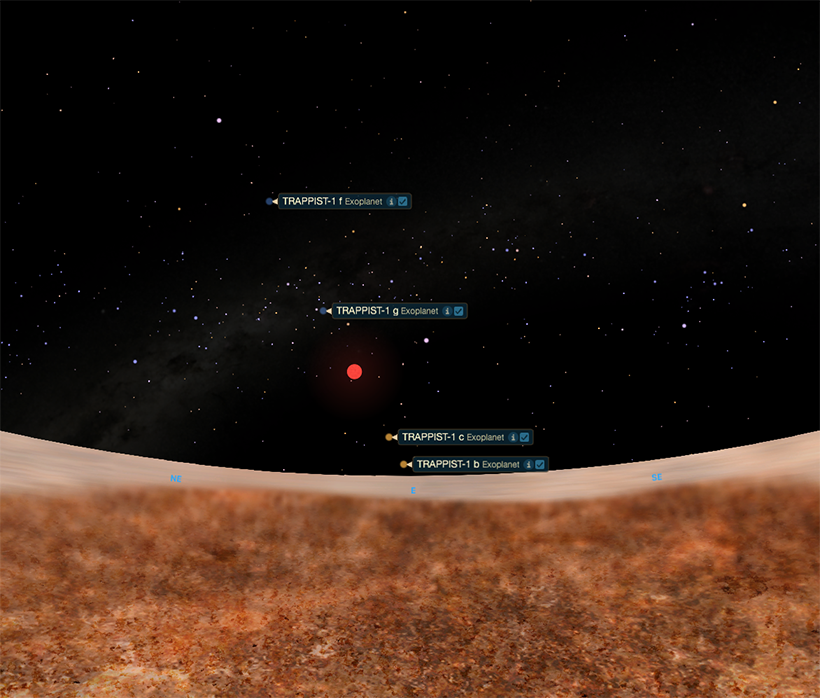
TRAPPIST-1e is the fourth closest planet to the star, and the first inside the habitable zone, orbiting in a near-circular orbit at a distance of only 4.21 million km (0.028 AU). It is approximately 62% the mass of the Earth, but only slightly smaller in radius (92%), making it a bit smaller than Venus. Its density is only 80% of Earth’s, suggesting an iron core and silicate rocky mantle composition similar to Earth, but with more water/ice or other lighter elements. It receives only 66% of the solar irradiance that Earth does, giving it a mean surface temperature of 251 K (-22°C). Some regions could support surface water, conditions favorable to Earth-like life, if its lower gravity is sufficient to hold an atmosphere.

The star’s size as viewed from the surface of TRAPPIST-1e would be 2.2 degrees across, more than 4 times larger than we see our own Sun. The planet is tidally locked to its star, keeping the same face towards it at all times. For a visitor to the sunward side of the planet, the dull red sun would hang in place, neither rising nor setting. The three inner planets would regularly cross the sky, probably transiting (but not eclipsing) the sun’s disk each time, and occulting one another. At solar conjunction, the closer one, TRAPPIST-1d would appear about as large as our moon does from Earth. On the opposite side of the planet, it would be perpetually dark, broken only by the other three planets racing across the sky, regularly passing near or in front of one another. Unlike our Solar System, the other TRAPPIST-1 planets are close enough to show as small disks, even with naked eyes. At closest approach, the next planet out, TRAPPIST-1f would cover 0.57 degrees, a bit larger than the moon does from Earth. Meanwhile, the distant stars would rise in the east and cross the sky to set in the west slower than they do on Earth. With a year only 6.10 Earth-days long, the entire celestial sphere would be observable every 146 hours!
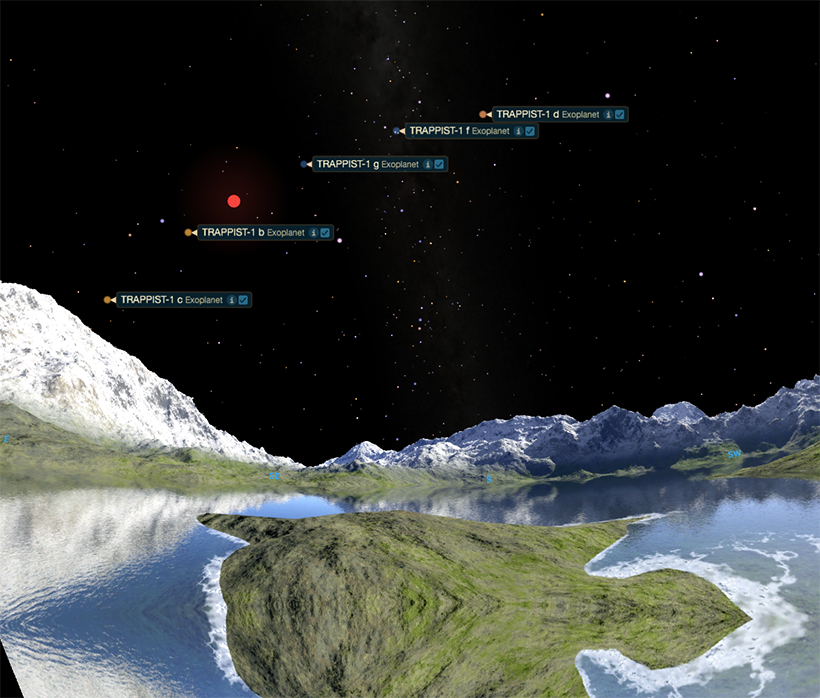
TRAPPIST-1f is the fifth closest planet to the star, and is well inside the habitable zone, orbiting in a near-circular orbit at a distance of only 5.55 million km (0.037 AU). It is approximately 68% the mass of the Earth and very slightly larger in radius. Its density is only 60% of Earth’s, suggesting it contains more interior water/ice or other light elements, similar to Jupiter’s moon Io. It receives only 38% of the solar irradiance that Earth does, giving it a mean surface temperature of 219 K (-54°C). Many regions could support surface water, conditions favorable to Earth-like life, if its lower gravity is sufficient to hold an atmosphere.
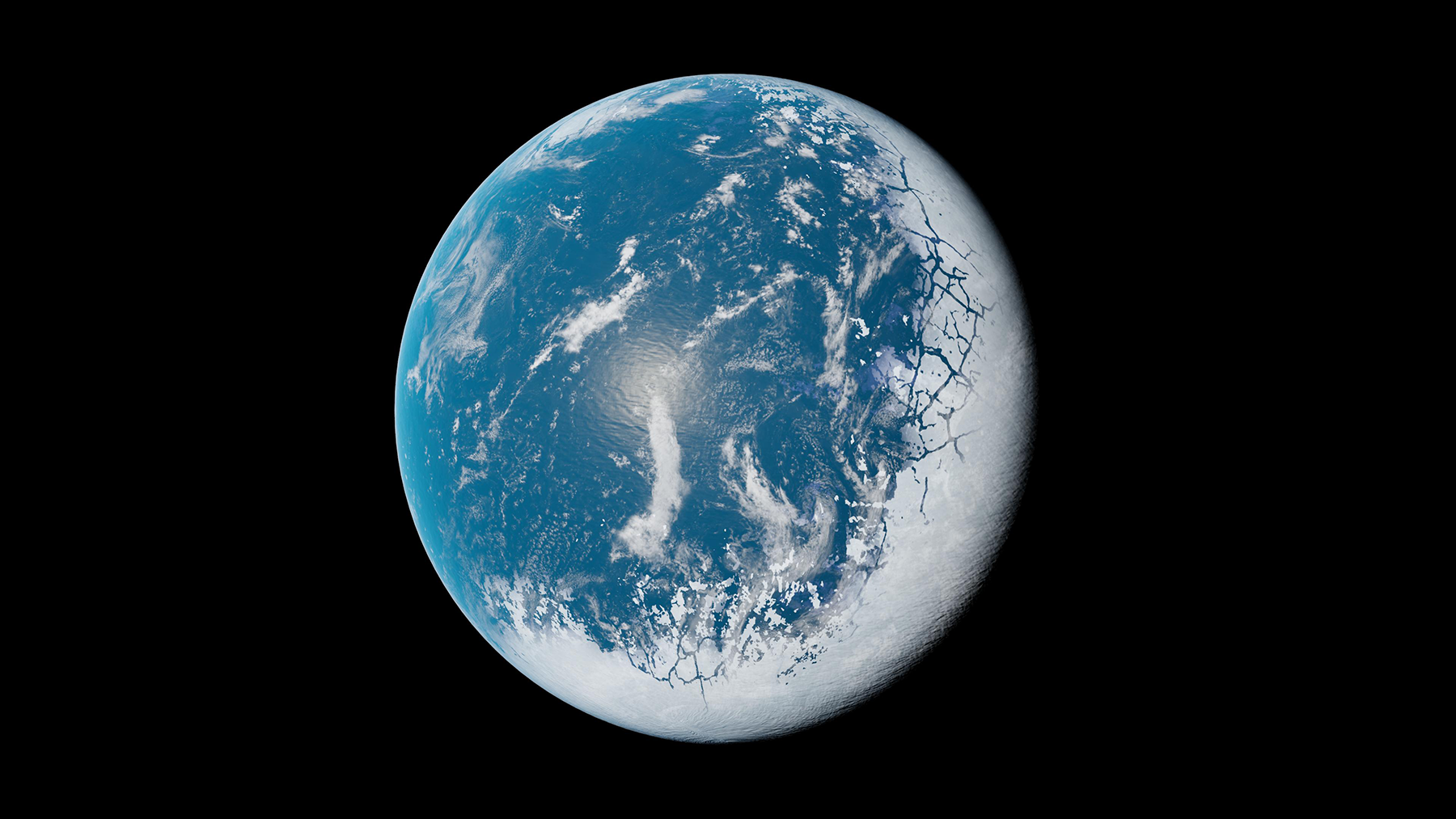
The star’s size as viewed from the surface of TRAPPIST-1f would be 1.7 degrees across, a bit more than 3 times larger than we see our own Sun. The planet is tidally locked to its star, keeping the same face towards it at all times. For a visitor to the sunward side of the planet, the dull red sun would hang in place, neither rising nor setting. The four inner planets would regularly cross the sky, probably transiting (but not eclipsing) the sun’s disk each time, and occulting one another. At solar conjunction, the closest one, TRAPPIST-1e would appear about as large as our moon does from Earth. On the opposite side of the planet, it would be perpetually dark, broken only by the outer two planets racing across the sky, regularly passing near or in front of one another. Unlike our Solar System, the other TRAPPIST-1 planets are close enough to show as small disks, even with naked eyes. At closest approach, the next planet out, TRAPPIST-1g would cover 0.69 degrees, one-third larger than the moon does from Earth! Meanwhile, the distant stars would rise in the east and cross the sky to set in the west, but much slower than they do on Earth. Still - with a year only 9.21 Earth-days long, the entire celestial sphere would be observable every 1.3 Earth-weeks!
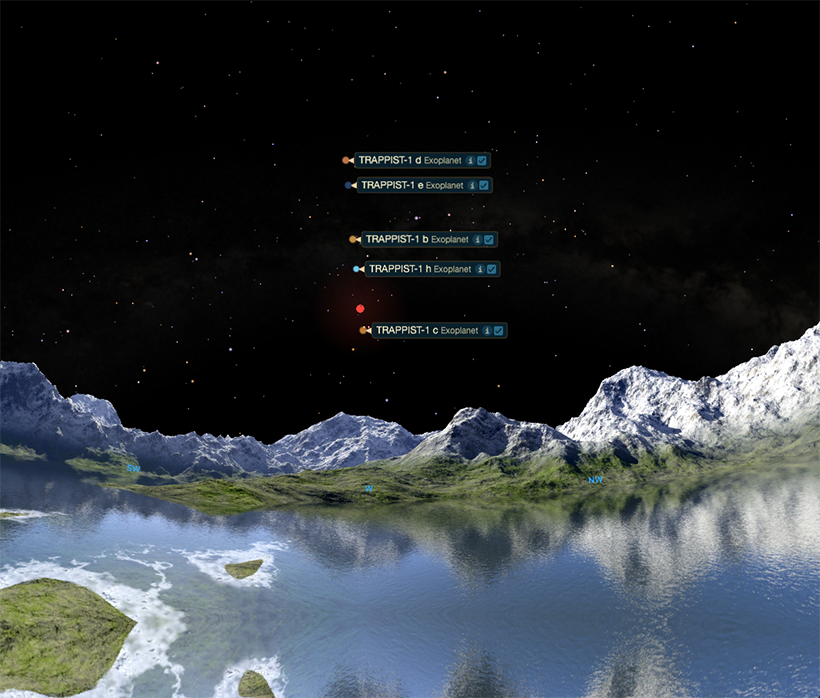
TRAPPIST-1g is the sixth closest planet to the star, the largest in radius, and the last one inside the habitable zone. It orbits in a near-circular orbit at a distance of only 6.74 million km (0.045 AU) from the star. It is approximately 34% more massive than the Earth and 13% larger in radius. Its density is only slightly lower than Earth’s, making it our distant doppelganger. It receives only a quarter of the solar irradiance that Earth does, giving it a mean surface temperature of 199 K (-74°C). Warmer regions could support surface water and conditions favorable to Earth-like life, since its gravity is sufficient to hold a substantial atmosphere.
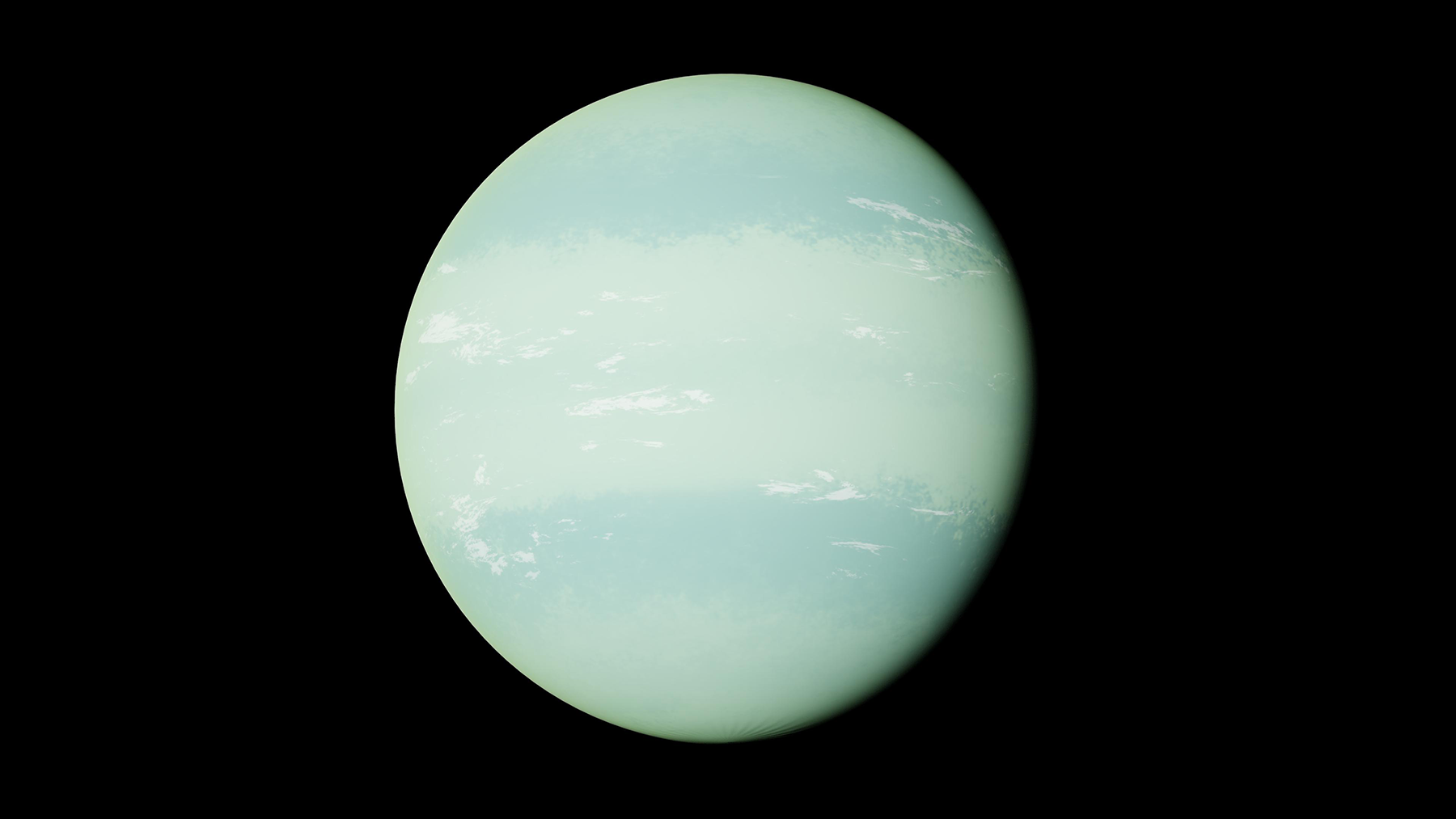
The star’s size as viewed from the surface of TRAPPIST-1g would be 1.4 degrees across, about 3 times larger than we see our own Sun. The planet is tidally locked to its star, keeping the same face towards it at all times. For a visitor to the sunward side of the planet, the dull red sun would hang in place, neither rising nor setting. The five inner planets would regularly cross the sky, probably transiting (but not eclipsing) the sun’s disk each time, and occulting one another. At solar conjunction, the closest one, TRAPPIST-1f would appear about one fourth larger than our moon does from Earth. On the opposite side of the planet, it would be perpetually dark, broken only by TRAPPIST-1h frequently racing across the sky. Unlike our Solar System, the other TRAPPIST-1 planets are close enough to show as small disks, even with naked eyes. At closest approach, the next planet out, TRAPPIST-1h would cover 0.21 degrees, less than half as large as the moon does from Earth. Meanwhile, the distant stars would rise in the east and cross the sky to set in the west, bit much slower than they do on Earth. With a year only 12.4 Earth-days long, the entire celestial sphere would be observable every 1.7 Earth-weeks!
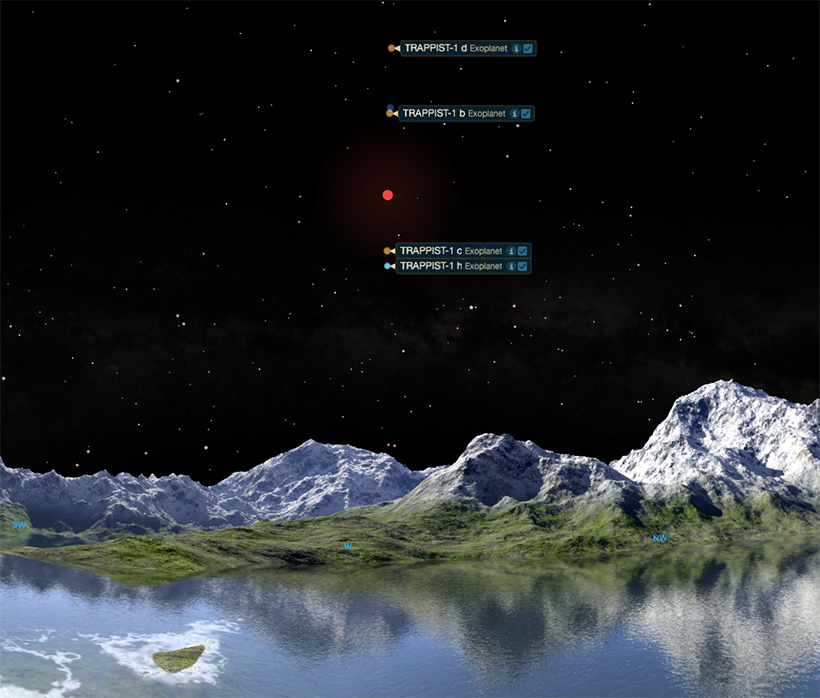
TRAPPIST-1h is the farthest planet from the star. It orbits in a near-circular orbit at a distance of only 9.42 million km (0.063 AU) from the star - too far to be habitable. Due to limited data, much less is known about the planet. We know that it is three quarters the size of Earth, but we haven’t yet determined its mass and density. It receives only 13% of the solar irradiance that Earth does, about as much as the main-belt asteroid Ceres, giving it a mean surface temperature of 168 K (-105°C) – too cold for surface water or Earth-type life.
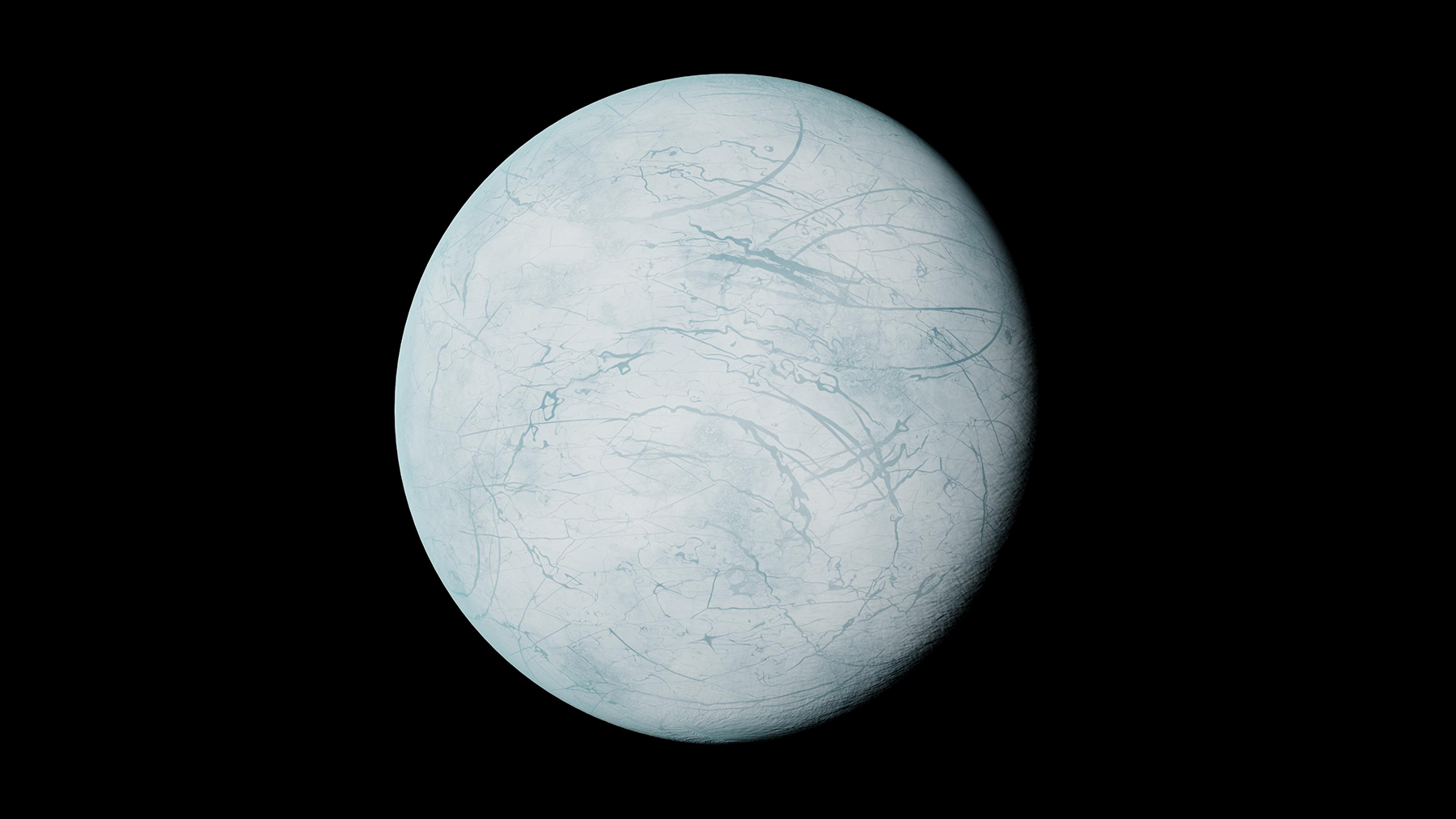
The star’s size as viewed from the surface of TRAPPIST-1h would be one degree across, about twice as large as we see our own Sun. The planet is probably tidally locked to its star, keeping the same face towards it at all times. For a visitor to the sunward side of the planet, the dull red sun would hang in place, neither rising nor setting. The six inner planets would regularly cross the sky, probably transiting (but not eclipsing) the sun’s disk each time, and frequently occulting one another. Unlike our Solar System, the other TRAPPIST-1 planets are close enough to show as small disks, even with naked eyes. At solar conjunction, the closest one, TRAPPIST-1g would appear about two-thirds of the size that our moon does from Earth. On the opposite side of the planet, it would be perpetually dark. The distant stars would rise in the east and cross the sky to set in the west, much more slowly than they do on Earth. With a year only 20 Earth-days long, the entire celestial sphere would be observable every three Earth-weeks!

While it will be several years before astronomers can study the TRAPPIST-1 planets’ atmospheres to determine whether any biological activity is present, it is fun to imagine what life would be like on TRAPPIST-1e, f, or g - the planets in the habitable zone.
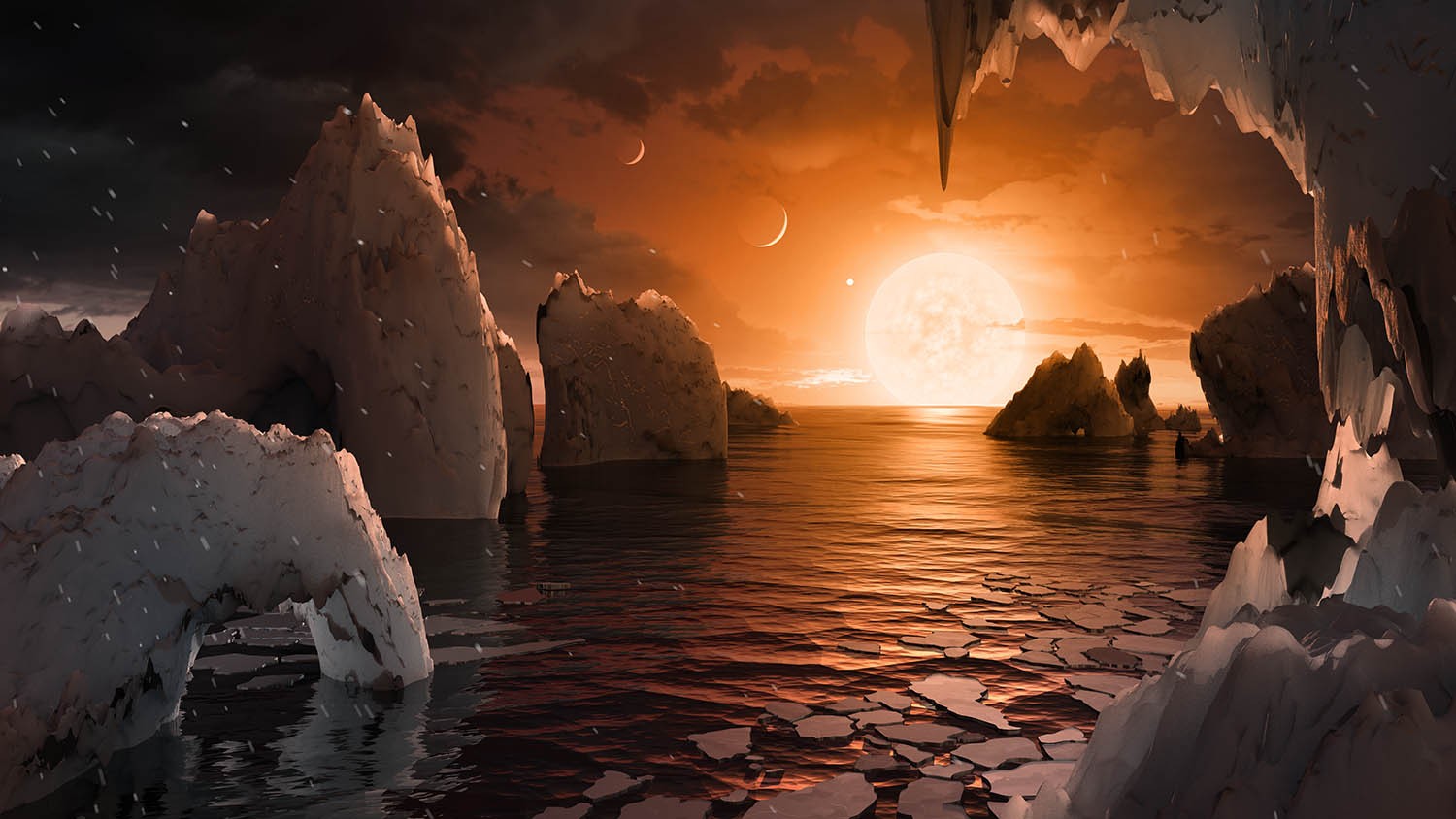
Planets that are tidally locked behave like our moon, rotating once per orbit (their year) while keeping the same part of the planet pointed at the star at all times. You’d need to decide whether to live in the constant sunshine of the daytime side, the constant darkness on the hemisphere facing away from the star, or a compromise. You’d likely take up residence somewhere along the terminator – the circle around the planet that separates the permanent day side from the permanent dark side. This way, the red dwarf star, your sun, would remain fixed in view near the horizon at all times. Or, you could dwell where the star is below the horizon and only the twilight glow is present – like a permanent sunset!
Cycles of day and night would not occur. The planets in the habitable zone orbit the star once every 6, 9, and 12 days respectively. If your planet has a tilt to its polar axis, you would see the sun shift north and south on a timescale of days. The differences in solar insolation would not last long enough to allow winter or summer to set in. The sunward side would be much warmer than the dark side, but planetary scientists predict that strong global wind systems would circulate to balance the temperatures.
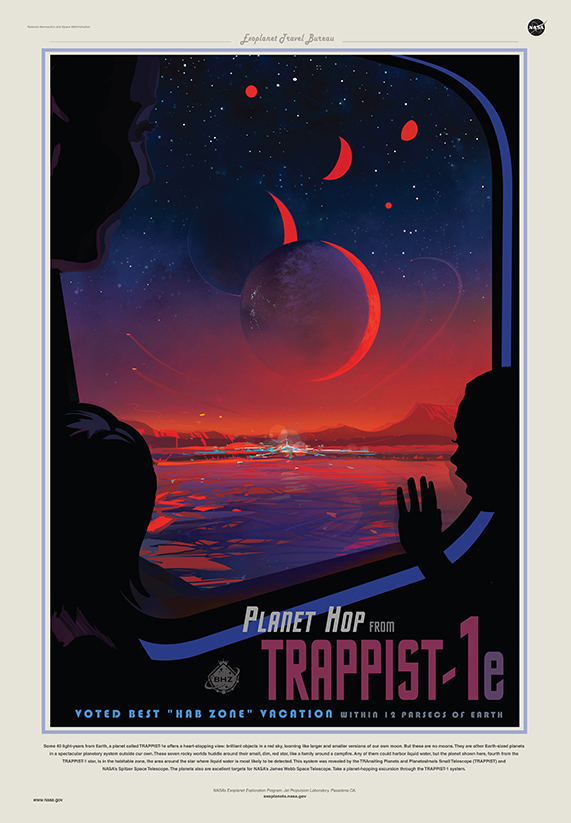
Your sun’s light would be much redder and duller than Earth’s. Beings would likely evolve larger eyes that are sensitive to the infrared part of the electromagnetic spectrum, and their skins could be dark-colored to absorb the meagre heat. Plant-life might have black vegetation. On the rocky, Earth-sized TRAPPIST-1 planets, gravity would be similar to Earth – ranging from between half and twice of ours. Complex life-forms would probably grow to similar heights and masses as Earth-life. If there is abundant surface liquid water, perhaps they’d be ocean-faring – or ocean dwelling!
If the TRAPPIST-1 planets have small orbital inclinations (tilts), they would frequently eclipse and occult one another. Instead of solar eclipses, you’d experience solar transits, possibly with multiple simultaneous transits repeating very often due to the short orbital periods of the seven planets. It appears that the TRAPPIST-1 planets’ orbital periods are close to resonance, meaning that their years differ by simple fractions, causing very frequent repetitions of their relative positions in space.
The small size of the TRAPPIST-1 system means that the planets are much closer together than those in our solar system, certainly allowing clear views of the surfaces of the other planets, even through a small telescope. In many cases, the neighboring planets would appear several times the size of our moon viewed from Earth! A technically advanced civilization would find interplanetary communications and travel much easier than in our solar system. Astronomy would be a regional pursuit. Solar astronomers would be able to monitor the star constantly from sun-side observatories, while stargazers would set up on the dark side of the planets and gaze back at us for as long as they wish!
As more transits of the TRAPPIST-1 planets are measured, the light curves will be refined, especially for distant TRAPPIST-1h. The edges of the dips in light can indicate whether an atmosphere is present. A sharp drop and rise suggests a hard edge to the planet, indicating either no atmosphere, or one very opaque to light. A gradual slope is indicative of an atmosphere that dims the light before cutting it off. Spectra taken of the dimmed light can capture signatures of chemicals and compounds in the atmosphere. Scientists are especially interested in detecting oxygen and other elements produced by life, or chemical compounds emitted by the industrial output of an advanced civilization.
In 2018, the successor to the Hubble Space Telescope – the James Web Space Telescope (JWST) - will be launched into orbit. This telescope will gather about six times more light than Hubble, with finer resolution and at infrared wavelengths of light well suited for studying the atmospheres of exoplanets and detecting the chemical fingerprints of life.
NASA’s Transiting Exoplanet Survey Satellite (TESS), expected to also launch in 2018, is a space telescope designed to search for exoplanets using the transit method. The primary mission will see TESS survey the brightest stars near the Earth for transiting exoplanets over a two-year period.
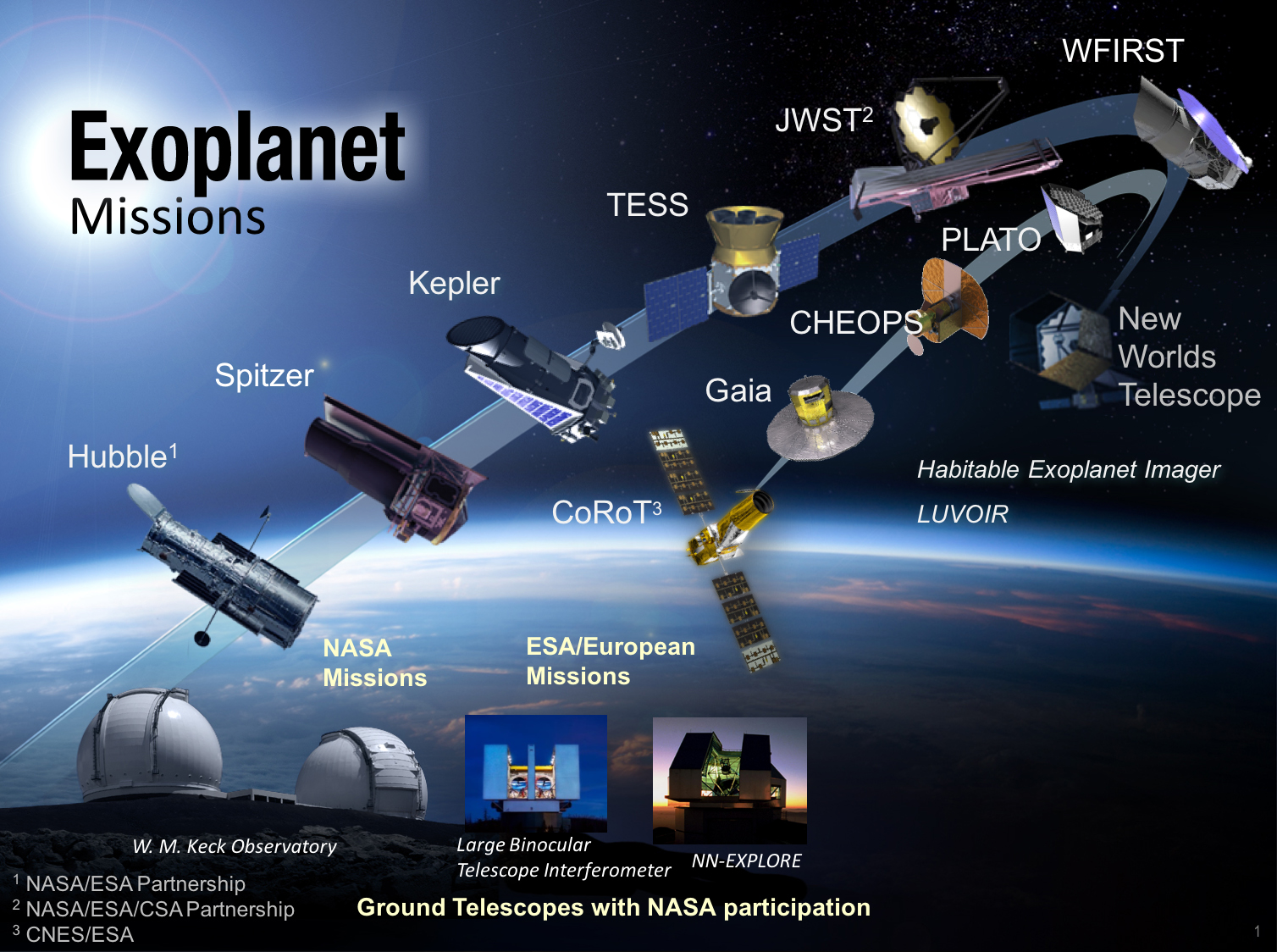
The Starshade Project is a proposal that will use two spacecraft – one a specially shaped occulting disk, reminiscent of a lotus flower, and the other a space telescope, to hide distant stars’ direct light, while orbiting exoplanets are imaged directly. It will enable spectra of planetary atmospheres to be measured, free of the primary star’s light.
The hunt for exoplanets is entering an exciting new phase of discovery. It is possible that within our lifetime, we might finally answer the question – are we alone in the universe?